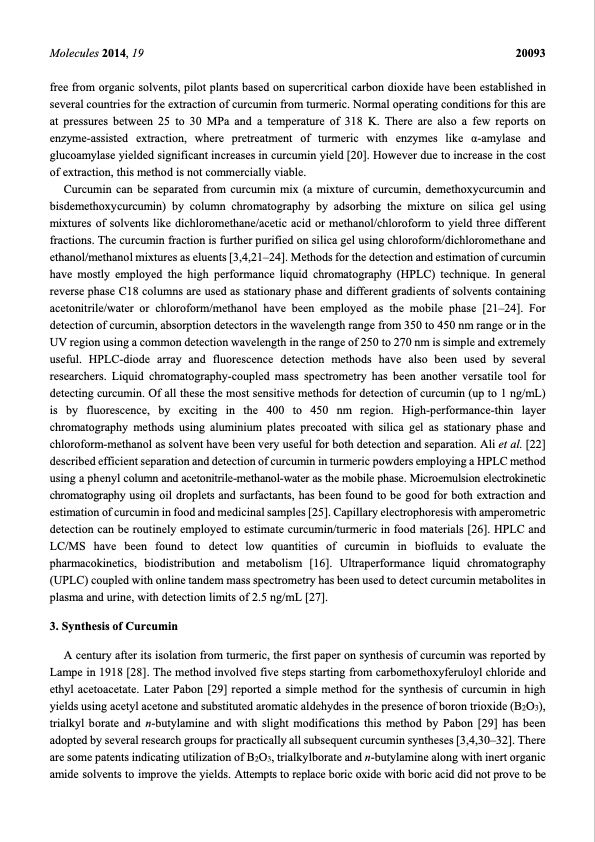
PDF Publication Title:
Text from PDF Page: 003
Molecules 2014, 19 20093 free from organic solvents, pilot plants based on supercritical carbon dioxide have been established in several countries for the extraction of curcumin from turmeric. Normal operating conditions for this are at pressures between 25 to 30 MPa and a temperature of 318 K. There are also a few reports on enzyme-assisted extraction, where pretreatment of turmeric with enzymes like α-amylase and glucoamylase yielded significant increases in curcumin yield [20]. However due to increase in the cost of extraction, this method is not commercially viable. Curcumin can be separated from curcumin mix (a mixture of curcumin, demethoxycurcumin and bisdemethoxycurcumin) by column chromatography by adsorbing the mixture on silica gel using mixtures of solvents like dichloromethane/acetic acid or methanol/chloroform to yield three different fractions. The curcumin fraction is further purified on silica gel using chloroform/dichloromethane and ethanol/methanol mixtures as eluents [3,4,21–24]. Methods for the detection and estimation of curcumin have mostly employed the high performance liquid chromatography (HPLC) technique. In general reverse phase C18 columns are used as stationary phase and different gradients of solvents containing acetonitrile/water or chloroform/methanol have been employed as the mobile phase [21–24]. For detection of curcumin, absorption detectors in the wavelength range from 350 to 450 nm range or in the UV region using a common detection wavelength in the range of 250 to 270 nm is simple and extremely useful. HPLC-diode array and fluorescence detection methods have also been used by several researchers. Liquid chromatography-coupled mass spectrometry has been another versatile tool for detecting curcumin. Of all these the most sensitive methods for detection of curcumin (up to 1 ng/mL) is by fluorescence, by exciting in the 400 to 450 nm region. High-performance-thin layer chromatography methods using aluminium plates precoated with silica gel as stationary phase and chloroform-methanol as solvent have been very useful for both detection and separation. Ali et al. [22] described efficient separation and detection of curcumin in turmeric powders employing a HPLC method using a phenyl column and acetonitrile-methanol-water as the mobile phase. Microemulsion electrokinetic chromatography using oil droplets and surfactants, has been found to be good for both extraction and estimation of curcumin in food and medicinal samples [25]. Capillary electrophoresis with amperometric detection can be routinely employed to estimate curcumin/turmeric in food materials [26]. HPLC and LC/MS have been found to detect low quantities of curcumin in biofluids to evaluate the pharmacokinetics, biodistribution and metabolism [16]. Ultraperformance liquid chromatography (UPLC) coupled with online tandem mass spectrometry has been used to detect curcumin metabolites in plasma and urine, with detection limits of 2.5 ng/mL [27]. 3. Synthesis of Curcumin A century after its isolation from turmeric, the first paper on synthesis of curcumin was reported by Lampe in 1918 [28]. The method involved five steps starting from carbomethoxyferuloyl chloride and ethyl acetoacetate. Later Pabon [29] reported a simple method for the synthesis of curcumin in high yields using acetyl acetone and substituted aromatic aldehydes in the presence of boron trioxide (B2O3), trialkyl borate and n-butylamine and with slight modifications this method by Pabon [29] has been adopted by several research groups for practically all subsequent curcumin syntheses [3,4,30–32]. There are some patents indicating utilization of B2O3, trialkylborate and n-butylamine along with inert organic amide solvents to improve the yields. Attempts to replace boric oxide with boric acid did not prove to bePDF Image | Curcumin: From Extraction to Therapeutic Agent

PDF Search Title:
Curcumin: From Extraction to Therapeutic AgentOriginal File Name Searched:
molecules-19-20091.pdfDIY PDF Search: Google It | Yahoo | Bing
CO2 Organic Rankine Cycle Experimenter Platform The supercritical CO2 phase change system is both a heat pump and organic rankine cycle which can be used for those purposes and as a supercritical extractor for advanced subcritical and supercritical extraction technology. Uses include producing nanoparticles, precious metal CO2 extraction, lithium battery recycling, and other applications... More Info
Heat Pumps CO2 ORC Heat Pump System Platform More Info
| CONTACT TEL: 608-238-6001 Email: greg@infinityturbine.com | RSS | AMP |